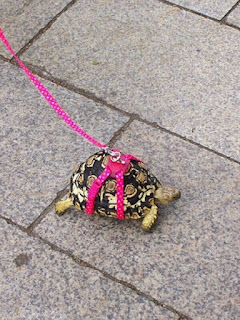 |
| Image Retrieved from: https://www.pinterest.com/pin/150307706290117222/ |
Are you walking a turtle on a
leash for the attention, or the particularly slow pace for better observation?
The term flaneur
originated in the Parisian arcades during the 19th century (Prouty,
2009) where aristocrats would stroll through the streets and take in their
environment one step at a time. A flaneur is someone who is indirectly and
unintentionally affected by the design or map of the area around them (Prouty, 2009).
They simply follow along the roads, past markets and shops to become what we
now call window
shoppers. Even on social media sites, including Instagram, there are cyber
flaneurs (Barnes, 1997). To browse through pictures of nature, people, food,
and adorable pets for a distraction from the real world. Or perhaps the
opposite, where they are the centre of attention with all their beautiful posts
and adventures mapped out for anyone to view. With hundreds of followers and
likes from users envious with their displayed #beautifullife. The user that
then link you all across the globe, just as an old nautical map would draw out
lines to connect one country to another for sailors.
Maps serve a variety of purposes whether it be for
directions across the city, navigating the Pacific Ocean, or determining where
the nation is swearing the most on networking sites (Kuttainen, 2015). A map can only serve out its desired purpose,
ask it to do any more and it becomes inaccurate. This can be the same with
Instagram or any other social media site, though they can be diverse with
cultures and expand all over the globe, they all had one original purpose; to
socialise. Though now days it’s slightly warped with advertising and internet
trolls, it’s still primarily used for communications between various people. Through
photos or status updates. And so I’ll ask again, are you a flaneur of
observation, or a flaneur for the attention?
References
Barnes,
G. (1997). Passage of the Cyber Flaneur.
Retrieved from http://www.raynbird.com/essays/Passage_Flaneur.html
Kuttainen,
V. (2015). BA1002:
Space: Networks, Narratives, and the making of
place, week 4 notes
[PowerPoint slides]. Retrieved from https://learnjcu.jcu.edu.au
Prouty,
R. (2009) One-Way Street: Turtle on a
Leash. Retrieved from http://www.onewaystreet.typepad.com/one_way_street/2009/10/a-turtle-on-a-leash.html
I agree versions of cyber flaneurs can definitely be found on social media sites, it almost seems as if social media sites were invented especially for the flaneur. I couldn’t think of a more perfect environment where the flaneur could flourish than Instagram. In my experience it seems the majority of users of Intagram are going there to serve one of the two purposes of the flaneur, either to see or be seen. When I think of my own actions on Instagram I enjoy both roles of the flaneur. I enjoy posting pictures of my life to be seen and also roaming around Instagram and seeing what other users have to post. I would even go as far as to wander if there is way of using Instagram without taking on either role of the flaneur.
ReplyDeleteReference
Prouty, R. (2009). One-Way Street. Retrieved from http://www.onewaystreet.typepad.com/one_way_street/2009/10/a-turtle-on-a-leash.html